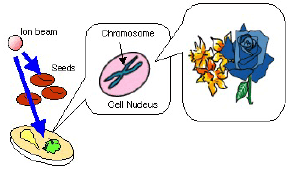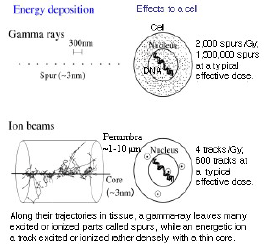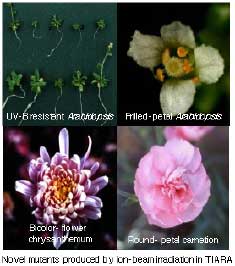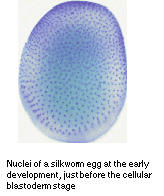PRODUCTION
Ion beam is a productive tool to exploit new fields of Biology
Ion-beam breeding of plant
 New mutant varieties give us useful gene resources for the security of food resources, the conservation of our ecosystem, and the promotion of new industries. A lot of fascinating new mutants are generated by ion beams.
New mutant varieties give us useful gene resources for the security of food resources, the conservation of our ecosystem, and the promotion of new industries. A lot of fascinating new mutants are generated by ion beams.
What is hte characteristics of ion beams for plant breeding?
 Ion beams can deposit high energy in a target densely and locally, contrary to radiation of low linear energy transfer (LET) such as gamma-ray, X-ray and electron-ray. When the target is biological cells, ion beams predominantly induce single- or double-strand DNA breaks with damaged end groups whose repairability is low. Therefore, ion beams can frequently cause large DNA alterations such as inversion, translocation and large deletion rather than point mutation, which result in producing characteristic mutants otherwise attainable.
Ion beams can deposit high energy in a target densely and locally, contrary to radiation of low linear energy transfer (LET) such as gamma-ray, X-ray and electron-ray. When the target is biological cells, ion beams predominantly induce single- or double-strand DNA breaks with damaged end groups whose repairability is low. Therefore, ion beams can frequently cause large DNA alterations such as inversion, translocation and large deletion rather than point mutation, which result in producing characteristic mutants otherwise attainable.
For plant breeding, TIARA is equipped with facilities for ion-beam irradiation of seeds and pollen.
How many novel mutants can ion beams produce?
 Ion-beam irradiation of Arabidopsis seeds has produced the UV-B-resistant, the frilled-petal, and other novel mutants. Each of them was induced from 1,280~1,488 irradiated seeds. The resulting mutation frequency is 8 to 33 times higher than that by electrons. Meanwhile, for chrysanthemum and/or carnation, ion beam irradiation has produced complex and striped flower-color mutants and new flower-shape ones that have never been induced by low LET radiation. These results indicate that ion beams can induce varieties of phenotypes. The features of ion beams in the mutation induction seem 1) to induce mutants with high frequency, 2) to show a broad mutation spectrum, and therefore, 3) to produce novel mutants.
Ion-beam irradiation of Arabidopsis seeds has produced the UV-B-resistant, the frilled-petal, and other novel mutants. Each of them was induced from 1,280~1,488 irradiated seeds. The resulting mutation frequency is 8 to 33 times higher than that by electrons. Meanwhile, for chrysanthemum and/or carnation, ion beam irradiation has produced complex and striped flower-color mutants and new flower-shape ones that have never been induced by low LET radiation. These results indicate that ion beams can induce varieties of phenotypes. The features of ion beams in the mutation induction seem 1) to induce mutants with high frequency, 2) to show a broad mutation spectrum, and therefore, 3) to produce novel mutants.
Cellular and subcellularbiology with heavy-Ion microbeams
A microbeam is a source of focused or collimated radiation for its effects to be localized into a micron-sized area in a specimen. The use of microbeam in biology dates back to the 1950s. However, we are now able to take advantage of recent developments in charged-particle delivery and detection, image processing and recognition, and computer technology, coupled with the benefits of modern biotechnology.
Now you have a novel tool for developmental biology:Cell-surgery with heavy ion microbeams
 The localized dose delivery of heavy ion microbeams can be applied to a microsurgery technique for analysis of cell-cell interaction in various animal cells or plant tissues by inactivation of a microscopic region in a target organism. In contrast with other microsurgery techniques like a UV-laser, a heavy ion microbeam is much more advantageous in inactivation of cell nuclei without damaging the surrounding tissue.
The localized dose delivery of heavy ion microbeams can be applied to a microsurgery technique for analysis of cell-cell interaction in various animal cells or plant tissues by inactivation of a microscopic region in a target organism. In contrast with other microsurgery techniques like a UV-laser, a heavy ion microbeam is much more advantageous in inactivation of cell nuclei without damaging the surrounding tissue.
A facility of collimated heavy-ion microbeam has been constructed at a vertical beam line of the AVF-cyclotron. Using this apparatus, a fate map of the silkworm, Bombyx mori, at the cellular blastoderm stage has been established from the relation between the irradiation position and the defect induced on the resultant embryos.
Why is the microbeam useful in studying cell response to radiation?
The biological advantage in the microbeam comes from its potential to specify energy absorption by a cell in terms of location, time, and hit-ion number.Using microbeams, we can deliver an exactly-counted number of ions to selected individual cells, and subsequently can observe what occurrs at the irradiated cells and at neighboring un-irradiated cells.
Use of microbeams allows direct investigation of cell-to-cell communications such as "bystander effects", in which radiation effects may be transmitted from irradiated cells to neighboring un-irradiated or "bystander" cells.
Furthermore, a microbeam with high spatial resolution will be useful for analyzing cellular spatial sensitivity, the interaction of damages produced by separate events, the dynamics of cellular repair, and the intra-cellular process such as apoptosis; that is, cell death by suicide, or programed cell death.

An image of two Mammalian cultured cells, overlaid with the image of etched ion-pits that was visualized after targeted microbeam irradiation.
